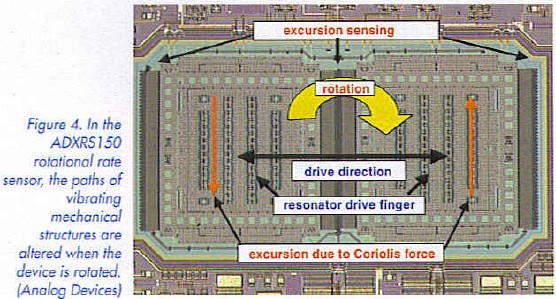

Project Solutions
Sensors Go Systematic (3)
Published:2011/7/28 3:07:00 Author:Amy From:SeekIC
By Helmuth Lemme
Bus connection
In systems with many sensors, it is economical to connect all of them to the computer via a common bus, rather than using individual cabling. This means that each sensor must have a bus coupler, which in many cases can also be housed on the chip. An early example of this type of component was the National Semiconductor LM75, which had a delta/sigma A/D converter and an PC bus interface on the same chip. A large demand for ICs of this type quickly arose, so new types were continuously developed and their range of functions was constantly enlarged to meet the wishes of users. They ultimately evolved into complex monitoring components, which (for example) can be used in PCs to monitor not only the temperature but also a whole range of other quantities, such as fan speeds. Figure 2 shows the block diagram of the LM87, which has so many functions that it has become a general-purpose "early warning system’ for all possible types of faults. Here the actual temperature sensor (at the bottom left) is only one of a host of elements. 
MEMS
Now that we have learned how to accurately produce mechanical structures with micrometre dimensions, it’s possible to integrate sensor elements that operate using moving pans, such as sensors for pressure, force, acceleration, and rotational motion. Where we previously encountered metallic or ceramic pans with dimensions in the millimetre or centimetre range, we now find miniature structures made from monocrystalline silicon, which together with their associated electronics form a monolithic block. This combination of micromechanics and microelectronics forms a micro-electromechanical system (MEMS).
The first products of this type to be manufactured in large volumes were acceleration sensors for triggering air bags in cars. They contain two interleaved comb structures made from silicon. with one of them being firmly attached and the other being suspended such that it can move. Capacitances in the femtofarad range (1 femtofarad = 10’ ’5 F) are created between these two structures. When the sensor is subjected to a mechanical impact, the movable comb is slightly displaced due to its inertial mass. This causes one capacitance to become larger and (he other one to become smaller, which is sensed using an electronic bridge circuit. Such sensors have proved to be extremely reliable, and more than 100 million pieces have been produced by now. Some of them are even sensitive in two directions, such as the Analog Devices ADXL202 illustrated in Figure 3 (www.analog.com). 
Airbags in cars have already saved many lives, but electronic stabilization systems can make an even greater contribution. They sense the rate of rotation of the vehicle about its vertical axis as the primary variable, and if it exceeds the maximum permissible value (as occurs with a skid), they initiate suitable steering and braking manoeuvres. In the event of rotation about the longitudinal axis (rollover), the airbags must inflate immediately.
Sensors for use in cars must be produced in large quantities at low costs. The glass-fibre gyroscopes used in avionics and space flight systems would be unaffordable. Here again components containing movable micromechanical structures have proven to be quite suitable, and they are already being produced by many manufacturers. They are based on the physical phenomenon of (he Coriolis force: if a mass in a rotating system is displaced linearly in a radial direction, it experiences a deflection in the tangential direction. In the Analog Devices ADXRS150, a flexibly suspended mass is excited into resonant vibration by electrostalic forces, with an amplitude of ±3.5 pm and a frequency of approximately 15 kHz. If the chip is subjected to rotation, a force perpendicular to the direction of oscillation is exerted on the vibrating element, and in a manner similar to the previously described acceleration sensor, this causes a change in the capacitance measured between two interleaved comb electrodes.
In its practical implementation, the IC uses two sensor cells whose masses oscillate in antiphase. Not only does this neutralise the external vibration of the IC, it also makes it less sensitive to disturbance from vehicle vibration. Figure 4 shows a portion of the chip, which measures only 3x3 mm. It is housed in a BGA package with dimensions of 7x7x3 mm.

Reprinted Url Of This Article: http://www.seekic.com/blog/project_solutions/2011/07/28/Sensors_Go_Systematic_(3).html
Print this Page | Comments | Reading(325)
Article Categories
New published articles
· Imagination works with TSMC to develop FinFET process
Author:Ecco Reading(30186)
· XMOS pushes event-driven MCUs with lower price
Author:Ecco Reading(3461)
· Intel brings upgraded 32-nm SoC for smartphones
Author:Ecco Reading(3181)
· Micron pushes TLC 128-Gbit NAND flash
Author:Ecco Reading(3662)
· Intel will stop supplying desktop motherboards
Author:Ecco Reading(5231)
· Processor market was expected to regain strength in 2013
Author:Ecco Reading(3248)
· It was reported that TSMC sales fall steeply
Author:Ecco Reading(3390)
· Cisco, NXP work with auto wireless startup
Author:Ecco Reading(3530)
· Micron was impacted by manufacturing glitch
Author:Ecco Reading(3935)
· China can make 22-nm transistor by themselves
Author:Ecco Reading(3707)
· Chip market rebound is coming, according to survey
Author:Ecco Reading(3677)
· Sony, Toshiba will spend more on chips, iSuppli reports
Author:Ecco Reading(3714)
· Qualcomm becomes the 13th company to join NFC Forum board
Author:Ecco Reading(6028)
· TSMC increases building work for FinFET fab
Author:Ecco Reading(3692)
· TI plans to cut 1,700 jobs in OMAP shift
Author:Ecco Reading(4478)